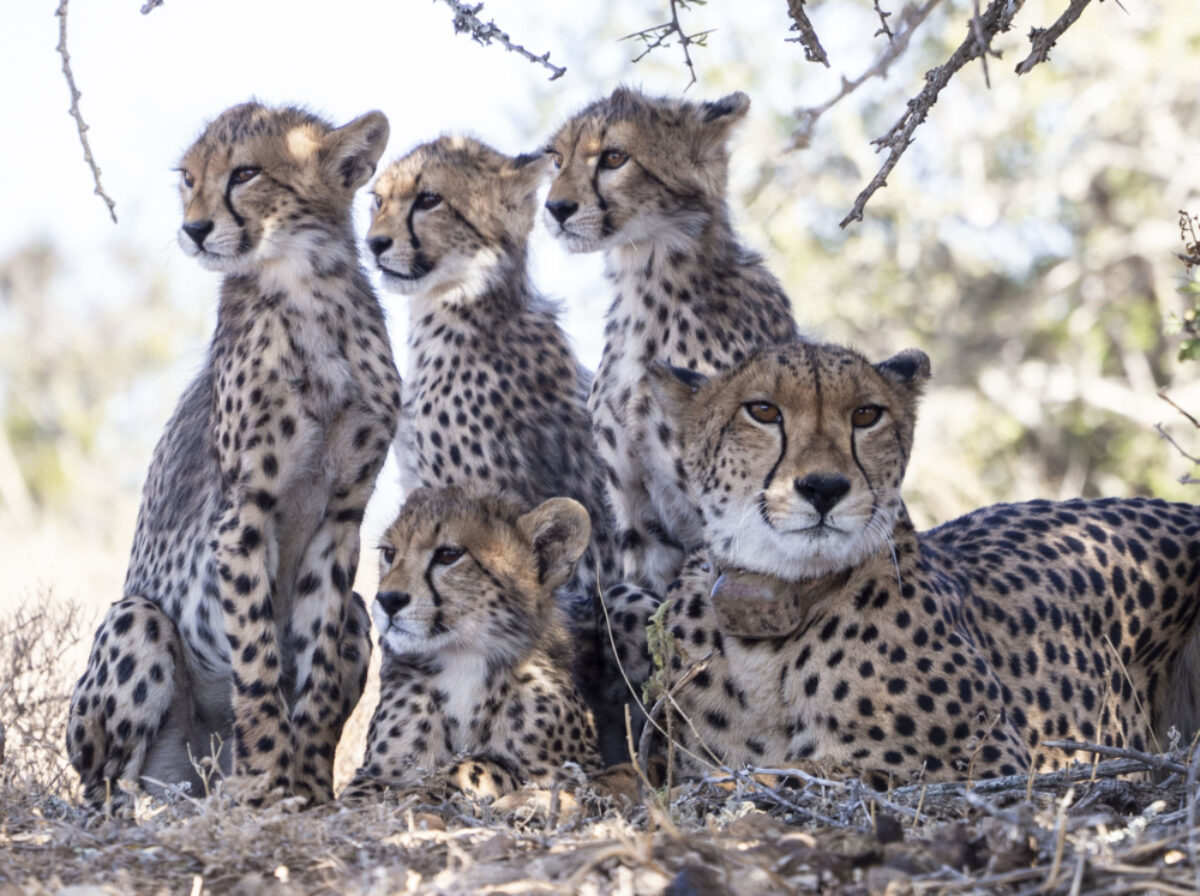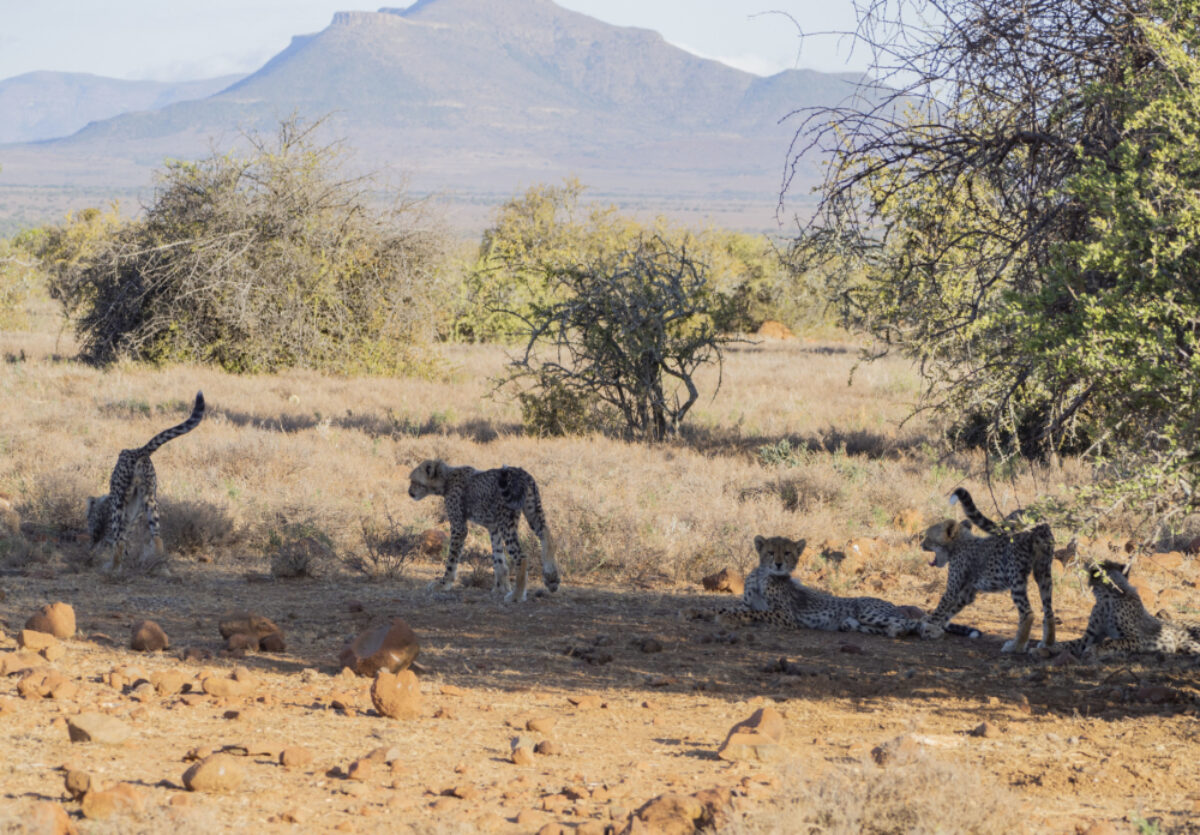Meeting the cheetahs of the Karoo
Rewilding in South Africa's magical desert outback
As we creep slowly through the bush towards a gnarled spikethorn tree, I suddenly catch a glimpse of spotted fur: the large amber eyes of a tiny cheetah cub curiously peering through the prickly branches at us. We move as quietly as possible around the tree, dry, brittle grass crunching underfoot, and find mother Chilli reclining in the shade with her five fluffy four-month-old cubs.
Our guide Julius thinks there are two females and three males. The family regard us a little warily at first before visibly relaxing, collapsing onto their sides, Chilli’s eyelids drooping; these cheetahs are used to visitors on foot and will tolerate us as long as we keep a respectful distance. The cubs are Chilli’s second litter and part of the successful reintroduction of cheetahs to the Great Karoo.
The Karoo is an enormous semi-desert region that spans approximately 40% of South Africa. It’s split between the more verdant Klein Karoo (Little Karoo) in the Western Cape province and the vast, dusty Great Karoo, which sprawls across the Western, Northern and Eastern Capes.
Samara Karoo, the 70,000-acre private reserve in which we find Chilli and her cubs, is in the Great Karoo, about 7.5 hours east of Cape Town or three hours north from Port Elizabeth. Samara is a striking landscape of rolling hills, great plains, orange dirt, warped trees and sun-scorched grass. It’s a harsh, arid environment – and yet, full of life.

Before the colonists arrived, the Great Karoo was rich in wildlife: giant Cape lions, now extinct and so fearsome settlers refused to ride at night; quaggas, a zebra subspecies, also now extinct; elephants; hippos; rhinos; and great migrations of springbok. Most of these animals were hunted out or their movements brought to a halt when farming fences went up. The last recorded sighting of a wild cheetah in the Great Karoo was during the 1870s.
Sarah Tompkins, co-owner of Samara, has made it her personal mission to rewild this part of South Africa. She, and her husband Mark, bought the original Samara farm in 1997 and have since purchased ten others to grow the reserve, removing fences, livestock and alien plant species to allow the land to recover.
Reintroducing cheetahs
In 2004, Samara introduced three cheetahs – the first the area had seen in 125 years. One of these was the female Sibella, who had been rescued from a cage on a farm in the North West Province; she’d been locked up after the farm’s dogs had attacked her when she was two years old. Sibella underwent five hours of surgery and extensive rehabilitation before being moved to her new home at Samara Karoo along with two males, also from farming areas suffering from human-wildlife conflict.

Sibella flourished in her new home, living to the grand old age of 14 before she died of natural causes in 2015. She raised an incredible 19 cubs from four litters and – because Samara often switches cheetahs with other reserves to keep the gene pool healthy – her genes can be found in 15 different cheetah populations across South Africa. Despite her past trauma at the hands of humans, Sibella was always relaxed and comfortable around Samara’s guides and rangers, letting them walk with her and her cubs.
Chilli is one of Sibella’s daughters, so perhaps it’s no surprise she too is so at ease around us. The next day, we get another opportunity to spend time with her and the cubs; she wears a tracking collar, so it’s easy for guides to locate her on the expansive Samara property. This time, the cubs are much more playful, grooming each other and their mother, rubbing heads and nuzzling affectionately. Our guide Jan tells us this is the age they start becoming a bit of a nuisance to their mother, messing up her hunting as they try to learn the ropes themselves.
The decline of cheetahs
Cheetahs are very much under threat in the wild, with an estimated 7,100 left worldwide. They often find themselves the target of human-wildlife conflict – where they kill livestock and farmers respond by shooting or poisoning them – whilst other threats include reduced habitat and larger predators, such as lions.
Before we found Chilli, we’d spent the morning at a boma (enclosure) where Samara’s newest residents were getting used to their surroundings before their release: two young lions, one male and one female. This is another great coup for the reserve: with elephants, rhinos, leopards and buffalo already established, the addition of lions means Samara has become the only Big Five reserve in the Great Karoo. It’s a huge step in their rewilding goals.
This is the first time these cheetahs have had to live alongside lions, and they’ll have to adapt quickly – they’ll no longer be at the top of the food chain. Lions will quite happily steal carcasses from cheetahs and are often responsible for killing their cubs. Fortunately, Chilli’s cubs are just old enough not to be quite so vulnerable as the lions start to explore their new home.
Predators are essential parts of any ecosystem. Lions are bigger and hunt in groups, so they kill much more than the usually solitary cheetah, keeping the reserve’s populations of springbok, blesbok, wildebeest and zebra in check. That they typically kill the weakest animals also acts as disease control and promotes the strongest genes in the prey species.
The Tompkins’ hope to open up the whole area so animals can traverse freely, though local farmers are challenging the introduction of more predators. There’s a long-term aim to be part of a huge wildlife corridor connecting Addo Elephant National Park in the south-east of South Africa all the way up to Botswana. Time will tell if this will come to pass – but in the meantime, visiting Samara Karoo results in not only a thrilling and intimate safari experience but also an insight into the massive ecotourism benefits of careful rewilding and restoration.




